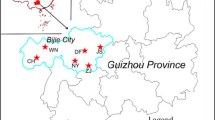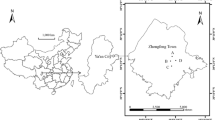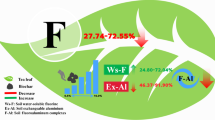Abstract
Purpose
Long-term tea plantation (Camellia sinensis L.) could markedly change the pools of total fluoride (T-F) in soil extractable fractions. However, the effects of different chronosequence phases on the changes of fluoride fractions in these plantations are poorly understood.
Materials and methods
In this study, we have investigated the distribution of extractable fluoride fractions in four differently aged tea plantations (16, 23, 31, and 53 years old, respectively), in Zhongfeng Township of Ming-shan County, Sichuan, Southwest China. This study aimed to determine the effects of the age of various tea plantations with respect the contents of T-F, also considering the water-soluble fluoride (Ws-F), the exchangeable fluoride (Ex-F), the Fe/Mn oxide-bound fluoride (Fe/Mn-F), the organic matter-bound fluoride (Or-F), and the residual fluoride (Res-F) within soil aggregates.
Results and discussion
The T-F, Ws-F, Ex-F, and Res-F contents increased with the decreasing of particle size except for Fe/Mn-F and Or-F. Along with the increase of tea plant life, the contents of Ws-F and Ex-F within soil aggregates gradually increased. In addition, the trends of extractable Fe/Mn-F and Or-F were opposite to that of highly available fluoride after 23 years.
Conclusions
The results of this study show that fluoride is easily transformed into highly available phases in long-term tea plantations, improving the absorption of fluoride for tea plants.

Similar content being viewed by others
References
Abrahams PW, Blackwell NL (2013) The importance of ingested soils in supplying fluorine and lead to sheep grazing contaminated pastures in the Peak District mining area of Derbyshire, UK. Environ Sci Pollut Res 20(12):8729–8738
Ayoubi S, Karchegani PM, Mosaddeghi MR, Honarjoo N (2012) Soil aggregation and organic carbon as affected by topography and land use change in western Iran. Soil Till Res 121:18–26
Brougham KM, Roberts SR, Davison AW, Port GR (2013) The impact of aluminium smelter shut-down on the concentration pf fluoride in vegetation and soils. Environ Pollut 178:89–96
Castro FC, Lourenço A, De FGM, Fonseca ICB (2002) Aggregate stability under different soil management systems in a red latosol in the state of Parana, Brazil. Soil Till Res 65:45–51
Cronin SJ, Manoharan V, Hedley MJ, Loganathan P (2000) Fluoride: a review of its fate, bioavailability, and risks of fluorosis in grazed-pasture systems in New Zealand. New Zeal J Agr Res 43:295–321
Denef K, Six J, Merckx R, Paustian K (2000) Short-term effects of biological and physical forces on aggregate formation in soils with different clay mineralogy. Plant Soil 246(2):185–200
Franzluebbers AJ, Arshad MA (1996) Water-stable aggregation and organic matter in four soils under conventional and zero tillage. Can J Soil Sci 76:387–393
Gao H, Zhang Z, Wan X (2012) Influences of charcoal and bamboo charcoal amendment on soil-fluoride fractions and bioaccumulation of fluoride in tea plants. Environ Geochem Hlth 34(5):551–562
Institute of Soil Science, Chinese Academy of Sciences (1978) The soil physical and chemical analysis manual. Shanghai Science and Technology Press, Shanghai, China
Joshi S, Hlaing T, Whitford GM, Compston JE (2011) Skeletal fluorosis due to excessive tea and toothpaste consumption. Osteoporosis Int 22:2557–2560
Kamau DM, Spiertz J, Oenema O (2008) Carbon and nutrient stocks of tea plantations differing in age, genotype and plant population density. Plant Soil 307:29–39
Karak T, Abollino O, Bhattacharyya P, Das KK, Paul RK (2011) Fractionation and speciation of arsenic in three tea gardens soil profiles and distribution of As in different parts of tea plant (Camellia sinensis L.). Chemosphere 85:948–960
Kraal P, Nierop KGJ, Kaal J, Tietema A (2009) Carbon respiration and nitrogen dynamics in Corsican pine litter amended with aluminium and tannins. Soil Biol Biochem 41(11):2318–2327
Li W, Zheng ZC, Li TX, Zhang XZ, Wang YD, Yu HY, He SQ, Liu T (2015) Effect of tea plantation age on the distribution of soil organic carbon fractions within water-stable aggregates in the hilly region of Western Sichuan, China. Catena 133:198–205
Loganathan P, Hedley MJ, Wallace GC, Roberts AHC (2001) Fluoride accumulation in pasture forage and soils following long-term applications of phosphorus fertilisers. Environ Pollut 115:275–282
Loganathan P, Hedley MJ, Grace ND, Lee J, Cronin SJ, Bolan NS, Zanders JM (2003) Fertiliser contaminants in New Zealand grazed pasture with special reference to cadmium and fluorine: a review. Aust J Soil Res 41:501–532
Lu RK (2000) Soil and agricultural chemistry analysis. China Agricultural Press, Beijing, China
Pickering WF (1985) The mobility of soluble fluoride in soils. Environ Pollut 9:281–308
Ruan JY, Wong MH (2001) Accumulation of fluoride and aluminum related to different varieties of tea plants. Environ Geochem Health 23:53–63
Ruan JY, Ma LF, Shi YZ, Han WY (2004) The impacts of pH and calcium on the uptake of fluoride by tea plants (Camellia sinensis L.). Ann Bot 93:97–105
Scholz LM, Kopittke PM, Menzies NW, Dalzell SA, Macfarlane DC, Wehr JB (2015) Use of fluoride-containing water for the irrigation of soil-plant systems. J Agr Food Chem 63(19):4737–4745
Simpson A, Shaw L, Smith AJ (2001) The bioavailability of fluoride from black tea. J Dent 29:15–21
Six J, Elliott ET, Paustian K (2000) Soil macroaggregate turnover and microaggregate formation: a mechanism for C sequestration under no-tillage agriculture. Soil Biol Biochem 32(14):2099–2103
Svoboda P, Vlcková H, Nováková L (2015) Development and validation of UHPLC-MS/MS method for determination of eight naturally occurring catechin derivatives in various tea samples and the role of matrix effects. J Pharmaceut Biomed 114:62–70
Wang SQ, Zheng ZC, Li TX, Li Y (2013) Effects of age of tea plantations on distribution of exchangeable base cations in soil aggregates. Acta Pedol Sin 50:99–106
Wenzel WW, Blum WEH (1992) Fluorine speciation and mobile in F contaminated soil. Soil Sci 153:357–364
Wu J, Wang W, Liu Y, Sun J, Ye Y, Li BY, Liu XN, Liu HX, Sun ZQ, Li M, Cui J, Sun DJ, Yang YM, Gao YH (2015) Modifying role of GSTP1 polymorphism on the association between tea fluoride exposure and the brick-tea type fluorosis. PLoS One 10(6), e0128280
Xie ZL, Chen Z, Sun WT, Guo XJ, Yin B, Wang JH (2007) Distribution of aluminum and fluoride in tea plant and soil of tea garden in central and southwest China. Chin Geogr Sci 17:376–382
Yin JL, Zheng ZC, Li TX (2015) Distribution of total fluoride and water-soluble fluoride in soil aggregates under tea plantation of different years. J Agro-Environ Sci 34:1754–1760
Yu QY, Ci E, Yang LZ (2007) Contents of different soil fluorine forms in North Anhui and their affecting factors. Chinese J Appl Ecol 18(6):1333–1340
Zhang L, Li Q, Ma LF, Ruan JY (2013) Characterization of fluoride uptake by roots of tea plants (Camellia sinensis (L.) O. Kuntze). Plant Soil 366:659–669
Zhang XC, Gao HJ, Wu HH, Yang TY, Zhang ZZ, Mao JD, Wan XC (2015) Ca2+ and CaM are involved in Al3+ pretreatment-promoted fluoride accumulation in tea plants (Camellia sinesis L.). Plant Physiol Biochem 96:288–295
Acknowledgments
The author would like to thank Wei Li for useful discussions related to this study. The authors would like to thank referees who give their valuable suggestions on the manuscript.
Author information
Authors and Affiliations
Corresponding author
Additional information
Responsible editor: Claudio Bini
Rights and permissions
About this article
Cite this article
Yin, J., Zheng, Z., Li, T. et al. Effect of tea plantation age on the distribution of fluoride and its fractions within soil aggregates in the hilly region of Western Sichuan, China. J Soils Sediments 16, 2128–2137 (2016). https://doi.org/10.1007/s11368-016-1409-2
Received:
Accepted:
Published:
Issue Date:
DOI: https://doi.org/10.1007/s11368-016-1409-2




